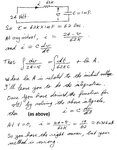Gauthier
Newbie level 6
Hi,
Let me give you the problem that bring me to that question,
First, I have 24 Vcc source that aliments R1=62KΩ in series with C1= 1000µF, very basic circuit...
The first question asks me to calculate the voltage drop at C1 and curent in the circuit at intervals of 30 secondes and to trace the exponential curves. The capacitor is charging from 0V, with the time constant of 62 and this formula Vc=Vs(1-e(-t/RC)) for Voltage at C1 and this one Ix = Iinitial(e(-t/RC)). The way I have calculate the initial current is 24V/62kΩ supposing that at the begining C1 is like a short.
Now the second question asks me to trace both curve of the same circuit, the only parameter that changes is when the charging begin C1 is already at 5V of Voltage drop.
I'm ok for the voltage curve: VC1= 24V+(5V-24V)e(-30/62), so when the switch is turned on, the VC1=5V and at 30 sec VC1=12.2V compared to when C1 start charging from 0V, when the switch is turned on VC1 =0V and at 30 secondes VC1=9.2V
My problem is with the the current curve: I think I have to find the current when the VC1 is at 5V, first I used the voltage divider formula...
If there's a 5V drop at C1 there's a 19V drop at R1... so 19V=(62kΩ/Rtot)24V Rtot= 78.3kΩ
Initial current= 24V/78.3KΩ
Initial current= 306µA
After I can use this formula: 306µA(e(-30/62))...
Do I treat the resistance of capacitor alimented with C.C. voltage source juste like a real resistance or it's capacitive reactance like with a sinusoidal alimentation.... I'm a little confuse.
And I would like to know, example if I have this: 5V=24V( (1-e(-t/62)), How do I isolate the ''t'' ?
Best regards
thanks
Alex
Let me give you the problem that bring me to that question,
First, I have 24 Vcc source that aliments R1=62KΩ in series with C1= 1000µF, very basic circuit...
The first question asks me to calculate the voltage drop at C1 and curent in the circuit at intervals of 30 secondes and to trace the exponential curves. The capacitor is charging from 0V, with the time constant of 62 and this formula Vc=Vs(1-e(-t/RC)) for Voltage at C1 and this one Ix = Iinitial(e(-t/RC)). The way I have calculate the initial current is 24V/62kΩ supposing that at the begining C1 is like a short.
Now the second question asks me to trace both curve of the same circuit, the only parameter that changes is when the charging begin C1 is already at 5V of Voltage drop.
I'm ok for the voltage curve: VC1= 24V+(5V-24V)e(-30/62), so when the switch is turned on, the VC1=5V and at 30 sec VC1=12.2V compared to when C1 start charging from 0V, when the switch is turned on VC1 =0V and at 30 secondes VC1=9.2V
My problem is with the the current curve: I think I have to find the current when the VC1 is at 5V, first I used the voltage divider formula...
If there's a 5V drop at C1 there's a 19V drop at R1... so 19V=(62kΩ/Rtot)24V Rtot= 78.3kΩ
Initial current= 24V/78.3KΩ
Initial current= 306µA
After I can use this formula: 306µA(e(-30/62))...
Do I treat the resistance of capacitor alimented with C.C. voltage source juste like a real resistance or it's capacitive reactance like with a sinusoidal alimentation.... I'm a little confuse.
And I would like to know, example if I have this: 5V=24V( (1-e(-t/62)), How do I isolate the ''t'' ?
Best regards
thanks
Alex
